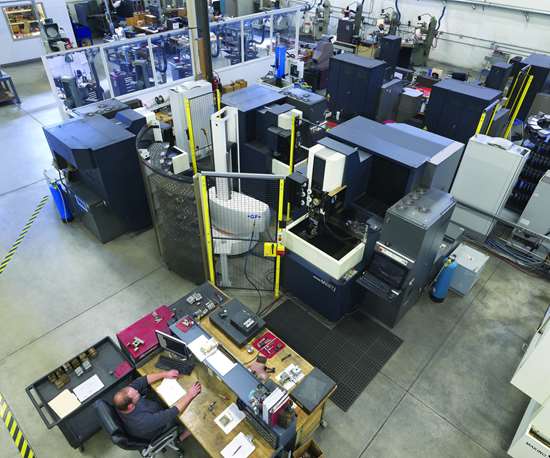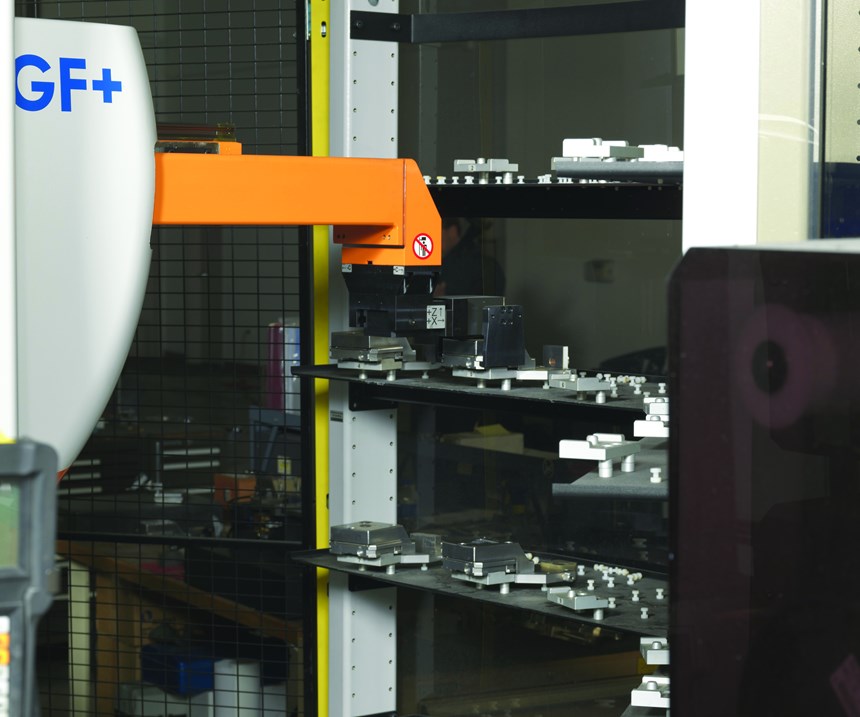Milling and EDM Automation Reshape Summit Tooling’s Mold Operations
Appears in Print as: 'Automated Machining Cells Simplify Moldmaking'
Summit Tooling President Dan Martin credits the capability to run unattended machining 24/7 to the partnership that his company built with Makino.
#industry40 #leadership #casestudy
Summit Tooling (McHenry, Illinois) routinely runs 24/7 unattended machining. Robots load and unload tooling and workpiece fixtures in three manufacturing cells, feeding nine machines that include a graphite mill, vertical mills and sinker and wire EDM machines. Summit Tooling President Dan Martin credits this capability to the partnership that his company built with Makino, which supplies Summit Tooling’s machine tools and the engineering services that Summit Tooling used to implement these complex automation systems.
Dan Martin and his wife Michelle founded Summit Tooling in 1996. The company designs and manufactures small to medium precision prototypes and production molds for a variety of applications including over-molds, two-shot injection molds, insert molds, spin-cavity technology, hydraulic-core pull technology and thin-wall molds. Customers hail from medical, pharmaceutical, consumer packaging and automotive markets as well as from the electric utilities industry. The company has 30 employees.
Featured Content
Efficiency through Automation Aids Growth
Like most mold manufacturing companies today, Summit Tooling competes with manufacturers from around the world that offer lower labor prices. Customer requirements for increasingly complex mold designs with tighter tolerances and demands for shorter lead times and reduced costs also challenge the company.
“The biggest challenge today is speeding up the moldmaking process to deliver products faster, and automation is the only way to do this,” Martin says. “Unattended run time is the main reason we are delivering projects much, much more rapidly today.”
Like most mold manufacturing companies today, Summit Tooling competes with manufacturers from around the world that offer lower labor prices.
Martin researched and met with a variety of mill and EDM suppliers, seeking not just a machine manufacturer but also a partner to play a strategic role in how Summit Tooling would grow. The company began investing in the first of its 11 Makino machines in 2008. The same year, Summit Tooling purchased an a61 horizontal machining center and two S33 vertical machining centers from Makino. Shortly thereafter, in 2011, Martin enlisted the support of Makino’s automation and engineering services to integrate the company’s first fully automated EDM cell, a Makino EDAF2 sinker EDM machine. Martin did not invest in full automation of loading and unloading of tooling, parts and fixtures at this point because, as he says, “I’m a conservative person, so I tend to move cautiously.” Nevertheless, Summit Tooling replaced 12 commodity milling machines with the three new Makino machines because of a host of tool monitoring and control capabilities that Makino machines provide as standard features that enable users to achieve extended machining hours with no labor costs.
“These milling machines provided a variety of technologies to help improve speed and efficiency,” Martin says. The a61 offered a ring-type, 60-tool magazine and an automatic pallet changer with a seven-second pallet-change time. On the S33 machines, we were able to reduce setups and improve utilization rates with a 20-position tool magazine and automatic tool changer (ATC) that performs tool exchanges in 1.3 seconds.”
Speed and efficiency were not the only noticeable changes in performance. Both the S33 and the a61 were equipped with Makino’s proprietary SGI geometric intelligence servo control, which Martin says “provided exceptionally smooth machined surfaces—even in high-feed rate machining operations and complex, 3D-shaped features.”
These early steps toward automation illustrated how well the machines performed on their own and led Martin to consider ways of organizing them into manufacturing cells. For the next step, Summit Tooling added a System 3R material-handling robot that Makino recommended to one of its existing commodity EDM machines.
“The first thought for many of our employees was, ‘You are trying to eliminate our jobs.’ No, we were making their jobs easier and more efficient so that we could push more work through and make more money. It is all about staying competitive and bringing in the revenue to provide good paying jobs, and there’s simply not enough qualified labor to grow otherwise,” Martin says.
Automation Investment Pays Dividends
Martin says that his company realized a full return on its investment of its initial automated manufacturing cell in about six months after the installation. Sales doubled while Summit Tooling continued running one shift and maintained the same number of mold shop employees. The company could do this because its EDM machines and horizontal and vertical machining centers were integrated using System 3R material-handling systems that could robotically load and unload electrodes and workpiece holding fixtures. This freed up the operator to handle other tasks like performing micro-welding for repairs and tooling alterations while keeping pace with EDM production.
These results led Summit Tooling to add a second EDAF2 EDM machine with a fine-hole EDM drilling option to the cell in 2012 for the purpose of producing high-tolerance, small-hole tooling features. The fine-hole machining option makes it possible for the EDAF2 to change 0.0039-inch-diameter by 12-inch-long pipe electrodes with its ATC. Special automatic dressing routines also are capable of discharge-dressing electrodes as small as 0.0035 inch in diameter, which can produce finished hole sizes of 0.004 inch in diameter using the EDAF2 fine-hole option.
“We have two customers that use nano-injection molding for surgical applications. You need a microscope to see the parts. Some are 0.125 inch in length and 0.003 inch in diameter. The fine-hole option allows us to produce holes smaller than 0.012 inch, which is a typical limit using traditional hole-popper EDM machines. The difference with the EDAF2 is that the holes it produces are always within size and straightness specifications,” Martin says.
Summit Tooling also has increased productivity 30 to 40 percent by replacing older commodity machines that required operators’ continual attention. Machinists can now manage several manufacturing cells simultaneously and take on new roles in the company’s growing plastic-injection molding operation. Operators set up automated cells and then run laser welders and other machines during their shift while the cells run unattended overnight and on weekends, providing improved delivery times.
Completely Automated Cells Change Processes
Martin made a bigger step toward full automation in 2011, when he hired Makino to integrate an EDM cell that includes a Makino F3 vertical graphite machining center with a pressurized system to vacuum carbon dust for high-speed electrode milling. The cell also has two EDAF2 sinker EDM machines for the production of slides, core pins, cores, cavity details and cavity-forming shapes. A larger System 3R Workmaster system feeds tooling and workpieces to each of the machines.
“Adding the cell changed how we do things enormously,” Martin says. “It takes a change in mindset to get used to running machines unattended 24/7. A change in mindset was especially necessary considering that now we can set up the machines, leave on Friday and then come back on Monday morning, realizing that we just ran 72 hours’ worth of work through three machines, and none of our employees were here.”
The company has since added two more automated cells. One is a milling cell with a Makino F5 vertical machining center that Summit Tooling installed in 2013 and integrated with the two S33 vertical machining centers that the company purchased in 2008 using a second System 3R Workmaster. This cell replaced nine commodity vertical mills. The second is an EDM cell that Summit Tooling installed in 2014–2015 combining two Makino U32j and one U53Tj wire EDM machines that are loaded and unloaded by a third System 3R Workmaster system.
The U32j and U53Tj wire EDM machines feature Makino’s Hyper-i control, which uses touch-screen controls with pinch, swipe and spread functions similar to functions in modern smartphones. According to Summit Tooling, operators have been able to adapt to the interface easily and implement it easily. The on-board digital manuals, help functions and e-learning training system have given operators practical support tools to boost machine productivity.
The Hyper-i control also includes HyperCut technology that Makino claims can produce a 3-micron-Ra (16-microinch-Ra) surface finish and 1-micron (0.00004-inch) straightness in three machining passes, while simultaneously reducing cycle time. After installing the first U32j, Summit Tooling tested it against one of its older commodity EDM machines by running a job that previously took 12 minutes. A Summit Tooling operator produced the same part, running the same program used on the older machines, in less than five minutes. Wire consumption is down by 14 percent.
“Our previous EDM machines were five to seven years old. We want to stay ahead of the technology curve, so we invested in these three Makino EDM machines because they utilize less wire, give better finishes and enable us to produce parts faster,” Martin says.
“Our previous EDM machines were five to seven years old. We want to stay ahead of the technology curve, so we invested in these three Makino EDM machines because they utilize less wire, give better finishes and enable us to produce parts faster.”
One of the reasons that Summit Tooling chose the U32j and U53Tj EDM machines was their programmable work tank and ergonomic access to the work zone. “The automatic rise-and-fall tank makes loading and setups easier for our operators in the non-automated configurations. At the same time, the automatic rise-and-fall tank supplies access to robotic loaders from three directions for our automated cells. It simply makes our lives a little easier across all processes,” Martin says. Summit Tooling also produces mold components with the a61 HMC and another EDAF2, both operated as stand-alone machines.
Automation Lays Foundation for Existence
Since 2008, sales have doubled while Summit Tooling has kept its mold and die shop employment steady at 16 operators, programmers and engineers. Operators program and load the three manufacturing cells to run unattended overnight and on weekends to increase productivity and to finish orders more quickly. Reduced labor costs that Summit Tooling realized by investing in automation and reliable high-performance machines enabled the company to further diversify its services by adding employees to the company’s growing plastic-injection molding business. Next in Summit Tooling’s drive to automate manufacturing is a plan for a third EDM cell. The company anticipates that a third cell will increase capacity and provide backup to help Summit Tooling avoid any disruption in delivering molds and components on-time to customers.
Mold and die shop owners have viewed automation as expensive, complicated and better suited for higher-volume production of milled parts. Owners visiting Summit Tooling often tell Martin that their traditional, manual processes with an operator in front of every machine are necessary to produce the complex shapes and tight tolerances of prototypes, small orders for unique molds and cavity and component repairs. Martin and his team chose another way. “The reality is that had we not automated our moldmaking operations, we would not be in business,” Martin says. “Automation is hugely instrumental in our profitability and our ability to succeed in the tough times that our industry has had during the past several years.”
The reality is that had we not automated our moldmaking operations, we would not be in business.
RELATED CONTENT
-
Advantages and Disadvantages of Copper and Graphite Electrodes
Both copper and graphite provide approximately the same end result, so it is important for a shop to consider the advantages and disadvantages of each material in order to discover what would work best in their shop floor environment.
-
Let’s Be Clear About Aluminum
Within the injection molding industry, a negative perception of aluminum for anything but prototype plastic parts persists, despite aluminum tooling being able to produce and run almost any resin that steel can, as well as produce millions of shots with unfilled resin with uniform results.
-
Texturing Molds for Thermoplastics: Factors for Success
Factors to consider when selecting a texture or grain for a thermoplastic mold or die.














